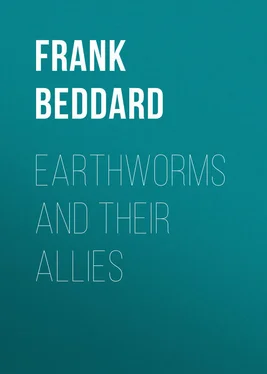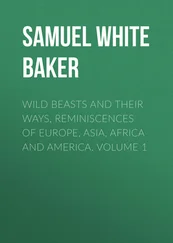Frank Beddard - Earthworms and Their Allies
Здесь есть возможность читать онлайн «Frank Beddard - Earthworms and Their Allies» — ознакомительный отрывок электронной книги совершенно бесплатно, а после прочтения отрывка купить полную версию. В некоторых случаях можно слушать аудио, скачать через торрент в формате fb2 и присутствует краткое содержание. Жанр: foreign_antique, foreign_prose, на английском языке. Описание произведения, (предисловие) а так же отзывы посетителей доступны на портале библиотеки ЛибКат.
- Название:Earthworms and Their Allies
- Автор:
- Жанр:
- Год:неизвестен
- ISBN:нет данных
- Рейтинг книги:3 / 5. Голосов: 1
-
Избранное:Добавить в избранное
- Отзывы:
-
Ваша оценка:
- 60
- 1
- 2
- 3
- 4
- 5
Earthworms and Their Allies: краткое содержание, описание и аннотация
Предлагаем к чтению аннотацию, описание, краткое содержание или предисловие (зависит от того, что написал сам автор книги «Earthworms and Their Allies»). Если вы не нашли необходимую информацию о книге — напишите в комментариях, мы постараемся отыскать её.
Earthworms and Their Allies — читать онлайн ознакомительный отрывок
Ниже представлен текст книги, разбитый по страницам. Система сохранения места последней прочитанной страницы, позволяет с удобством читать онлайн бесплатно книгу «Earthworms and Their Allies», без необходимости каждый раз заново искать на чём Вы остановились. Поставьте закладку, и сможете в любой момент перейти на страницу, на которой закончили чтение.
Интервал:
Закладка:
It will appear therefore that many and considerable differences divide Pontoscolex from Notiodrilus and indeed from all of the Megascolecidae whose structure has been touched upon in the foregoing pages. The most important of these are the ornamented setae and their arrangement and the modification of the setae upon the clitellum: the absence of diverticula to the spermathecae: the absence of terminal glands associated with the male ducts. Although taken in their entirety these characters are distinctive of the American Geoscolecidae (sub-family Geoscolecinae), there is no one of them which is not to be found in some Megascolecid. Thus the subgenus Ilyogenia (of Ocnerodrilus ) has sometimes no spermiducal glands: the genus Perionyx has spermathecae without diverticula in some species, and other genera of Megascolecinae are in a like condition. The setae of Dichogaster are sometimes ornamented, while in Pheretima houlleti the clitellar setae are different from those upon the other segments.
We can in fact only define the family Geoscolecidae by an assemblage of characters which are mainly these: dorsal pores absent, only a few in the neck region being occasionally present; setae generally ornamented, those of the clitellum being larger and more marked than the others; spermathecae without diverticula; often instead of a pair of those pouches in the segment a large number of very small sacs, as in Microchaeta , Kynotus . Sperm ducts without terminal glandular or muscular sac, except in a few cases; setae always eight in a segment except in the genus Periscolex which has acquired the 'perichaetous' condition. The range of variation shown in the anatomy of the Geoscolecidae will be best taken in connection with the several sub-families into which it has been subdivided. In the first of these, the Geoscolecinae, no great differences divide the genera from that selected as the type, viz. Pontoscolex . The long sperm sacs attain to an extraordinary length in Trichochaeta (or Hesperoscolex ) where the single pair extends through no less than 109 segments. Though as a general rule the sperm ducts open directly on to the exterior they do so through the intermediary of a large pouch in Glossoscolex (= Titanus ). In Onychochaeta the setae on the last segments of the body are very much enlarged and thus form a more effective means of holding on to the soil than is possessed by other species.
The sub-family Hormogastrinae which contains but a single genus Hormogaster is remarkable for being limited in range to the Mediterranean coasts. The genus is mainly distinguished by possessing three gizzards; otherwise it is not very different from the sub-family just described. The African and Madagascar forms are associated (together with a few Asiatic forms) into a third sub-family Microchaetinae. These worms frequently possess a considerable number of very small spermathecae in segments XII, XIII or thereabouts instead of the usual paired arrangement. They have too very often glands connected with the enlarged setae already mentioned which are however (in the genus Kynotus at any rate) usually in front of the clitellum. The latter organ, contrary to what we find among the Geoscolecinae, is often behind the point of orifice of the male pores. This is so with Kynotus .
The last sub-family, Criodrilinae, has but three genera Criodrilus , Sparganophilus and Alma . These worms do not show any very marked differences from other Geoscolecids. Alma is noteworthy for the facts that the male pores are borne upon long processes of the body which bear specially modified setae and that one species at any rate has gills.
Another type of structure is offered by the Eudrilid earthworms which form rather a restricted family. These worms are as a rule quite easy to distinguish by their external characters only. For the apertures of the spermathecae and sperm ducts are apt to be very large and conspicuous. They are also generally unpaired, a character which is however not confined to the Eudrilidae; for there are Megascolecids, such as Fletcherodrilus , and Geoscolecids in which the same unpaired character occurs. The principal feature of the family is that the ovaries are commonly enclosed in sacs – comparable to the sperm sacs which frequently envelop the spermaries in other earthworms – and that these sacs not only contain the mouths of the oviducts but are directly continuous with the single or double spermatheca. This is usually a large sac, always single or consisting of one pair only, which opens on to the exterior close to the oviducal pores; these spermathecae in the Eudrilidae are not comparable to the spermathecae of other earthworms; for they are in a way comparable to the sperm sacs, being formed as outgrowths of the septa. There is some variation of structure within the family. In a number which are associated into a sub-family Eudrilacea there are two paired calciferous glands and a single unpaired one, while the paired nephridia open by a large pore on to the exterior. In a parallel sub-family, the Pareudrilacea, the calciferous glands are apt to be more numerous and have a totally different structure: they have been apparently converted into non-digestive glands bearing some relation to the vascular system. The nephridia moreover do not open on to the exterior by single pores, but form a network within the thickness of the body wall and then open by numerous pores. There is however no resemblance here to the micronephridia of Dichogaster and other Megascolecids. In Libyodrilus (as an example of the Pareudrilacea) each nephridium forms a network out of the duct leading to the exterior. In the interior of the body a series of paired meganephridia are visible.
The earthworms of Europe belonging to the family Lumbricidae offer again a rather different type of structure, which is more reminiscent of the Geoscolecidae than of the Megascolecidae or Eudrilidae. In this family there are no glands appended to, or in the neighbourhood of, the orifices of the sperm ducts, such as are found in the other forms. As in the Geoscolecidae the clitellum is furnished with setae somewhat different in form from those which deck the body generally. These setae are never more than eight in a segment. Dorsal pores (absent in Geoscolecidae and in Eudrilidae) are invariably present. The spermathecae are without appendices and nearly always simply paired, though rarely we get numerous much smaller spermathecae in a single segment, as in Kynotus among the Microchaetine Geoscolecids. Internally the most striking feature of this family is to be seen in the position of the gizzard at the end of the oesophagus and at the beginning of intestine. The apertures of the male pores are – save for two or three exceptions where they are further forward – invariably upon the fifteenth segment, and the clitellum, often very long, usually begins behind this point, features which are also seen in Kynotus .
Finally we have the Moniligastridae which differ from all the types hitherto considered in a few rather important particulars. These worms are named on account of the fact that they possess several gizzards upon the oesophagus, a character which is however met with in the Megascolecid genus Plionogaster and in certain Eudrilids, e. g. Hyperiodrilus . The main peculiarity of the family is that the sperm ducts are very short and open on to the next segment to that which contains the spermaries, as in the water-living Oligochaeta generally. The terminal sac into which the male ducts open is moreover rather like that of such a family as the Lumbriculidae.
The Aquatic Families of Oligochaeta
Интервал:
Закладка:
Похожие книги на «Earthworms and Their Allies»
Представляем Вашему вниманию похожие книги на «Earthworms and Their Allies» списком для выбора. Мы отобрали схожую по названию и смыслу литературу в надежде предоставить читателям больше вариантов отыскать новые, интересные, ещё непрочитанные произведения.
Обсуждение, отзывы о книге «Earthworms and Their Allies» и просто собственные мнения читателей. Оставьте ваши комментарии, напишите, что Вы думаете о произведении, его смысле или главных героях. Укажите что конкретно понравилось, а что нет, и почему Вы так считаете.












